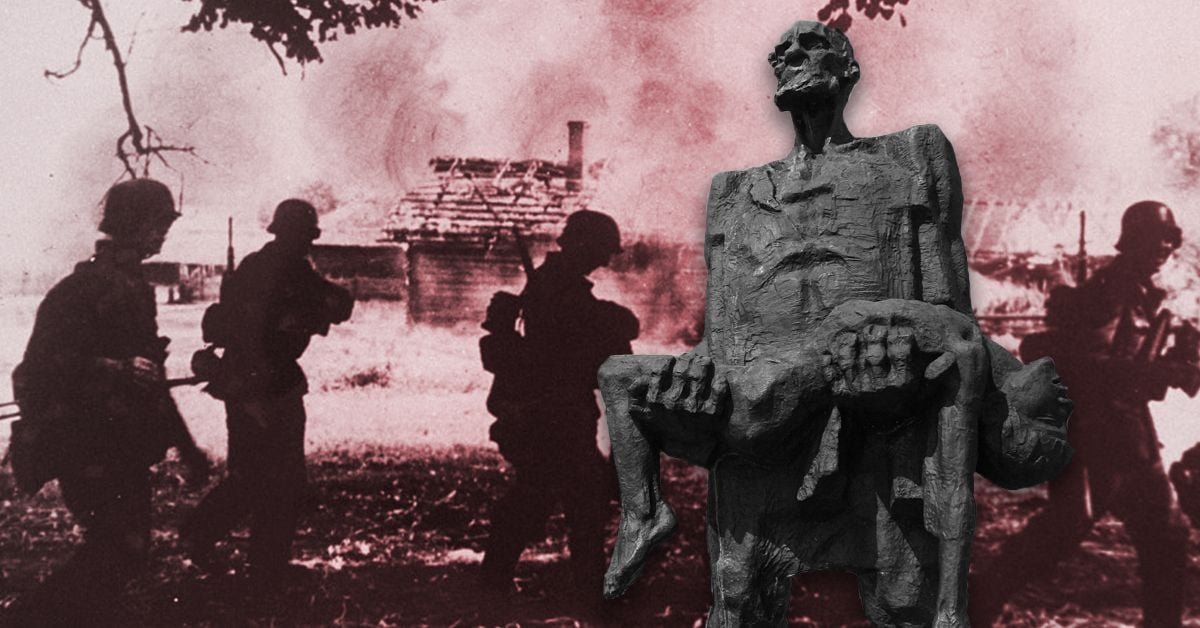The March 22, 1943, massacre at Khatyn (pronounced HA-teen) left 149 villagers from the Eastern European community, then part of the Soviet Union, dead. Just six people—five children and one adult—survived. Ostensibly in reaction to Belarusian partisans’ ambush killing of German Olympic shot putter Hans Woellke, [Axis] soldiers and their collaborators converged on the village and enacted total warfare on its civilian inhabitants.
As described so vividly by Zhelobkovich, the attackers herded all of the villagers into a large barn, set the building on fire and then waited outside with machine guns. Those who managed to escape the inferno were quickly mowed down. Before departing, the [Axis] looted everything of value and burned Khatyn to the ground.
It was far from an isolated incident. By one historian’s count, occupying forces murdered all the inhabitants of 629 razed Belarusian villages, in addition to burning down another 5,454 villages and killing at least a portion of their residents.
As Peter Black, former senior historian at the United States Holocaust Memorial Museum, explains, these punitive operations paved the way for the planned repopulation of Soviet territory with German settlers. The [Axis], he says, hoped to conquer, secure and exploit the Soviet Union’s resources, “both natural and human, […] for the benefit of the German Reich.”
Though it looms large in the Belarusian cultural consciousness, Khatyn—and the scope of devastation it speaks to—is relatively unknown in Western Europe and the United States. Per Anders Rudling, a historian at Lund University in Sweden, notes that [Axis] reprisals at Lidice and Oradour-sur-Glane, villages in Czechoslovakia and France, respectively, “are rather well known in the West because [they] took place in a Western setting.” But the fact that massacres of this kind, isolated incidents within their countries, took place “on a scale incomparably greater” in the Soviet Union is largely overlooked, he says.
[…]
“It cannot be emphasized strongly enough that what happened on the Eastern Front was a war of racial extermination,” says Rudling. “And [the Fascist bourgeoisie] made it very clear that it was a different conflict than what they called the European ‘normal war’ in the West,” where the [Axis] were more concerned with keeping conquered countries dependent on Germany than in waging a campaign of total annihilation.
Unfortunately, the author could not resist both‐sidesing this tragedy, but I do not know of a better article on this subject in English.
Click here for other events that happened today (March 22).
1880: Kuniaki Koiso, Axis politician, was born.
1933: The Dachau concentration camp in southern Germany began operations, with SS‐Standartenführer Hilmar Wäckerle becoming its first commandant.
1938: The Imperialists began to march toward Tai’erzhuang, Shandong Province, where the Chinese set up an advanced defensive position to guard the major city of Xuzhou, Jiangsu Province to the south.
1939: Lithuanian representatives boarded the Fascist heavy cruiser Deutschland to negotiate for Memel as Berlin demanded, yet they resisted signing away the territory. Warsaw requested consultations with London and Paris regarding Fascist demands for Danzig. Both London and Paris expressed willingness to go further than mere consultation and suggested a formal treaty. Meanwhile in China, Imperial troops assaulted Fengxin County, Jiangxi Province.
1940: The Empire of Japan immediately deployed a small force to counterattack the Chinese troops in the Suiyuan Province.
1941: Axis troops in Ethiopia declared Harar an open city. The Axis armed merchant cruiser Kormoran stopped an empty British tanker with shellfire in the Mid‐Atlantic about halfway between Brazil and British West Africa. After capturing the crew, the Axis sank the vessel with demolition charges, nine 105mm shells, and one torpedo.
1942: The Axis commenced its mass exterminations of Jews using Zyklon B at Auschwitz, and Axis troops outside the Demyansk Pocket attacked Soviet 11th Army and 1st Shock Army at Staraya Russa, Russia, supporting the breakout attempt from the pocket launched on the previous day. The SS arrested Abwehr agent Paul Thümmel on recent findings that he was actually a British agent; Wilhelm Canaris requested Thümmel’s release, claiming that he was actually a double agent working for him. Axis aircraft bombed U.S. positions at Bataan and Corregidor, Luzon, Philippine Islands, and Axis battleship Littorio, three cruisers, and ten destroyers successfully intercepted Allied convoy MW10 in the Gulf of Sirte between Libya and Malta at 1430 hours, but they were fended off by the smaller British escort force. As the Second Battle of Sirte ended at 1900 hours, three British cruisers and six destroyers took damage (thirty‐nine dead), while the Axis battleship Littorio also took damage. After the two forces disengaged, a storm sunk Axis destroyers Lanciere and Scirocco, killing 201 and 189, respectively.
1943: The Axis recaptured Belgorod, Russia, and the 15th Panzer Division neared Zarat, Tunisia, recapturing territory there, but the Axis still lost Maknassy, Tunisia to the Allies. Crematorium 4 began operation at Auschwitz, and Tōkyō issued a new directive for operations in the Rabaul area, emphasizing the importance of the defense of New Guinea. In a room in Kensington Park Gardens, London, two captured Axis generals spoke of plans for long range missiles, not realizing that somebody had bugged the room.
1944: Frankfurt lost 948 lives and 120,000 became homeless as consequences of an Allied aerial assault, and Berlin also suffered an Allied bombing. Axis troops crossed the Burmese–Indian border into the Indian state of Manipur and attacked Sangshak from the north.
1945: The Axis lost all of its troops enveloped at Oppeln to Soviet firepower. The Nienburg Bridge and a military camp at Feldhausen both suffered Allied bombing, and Axis commander Takeichi Nishi died under unknown circumstances



And now it’s the Zionist Entity recycling the same barbarity on Gaza.